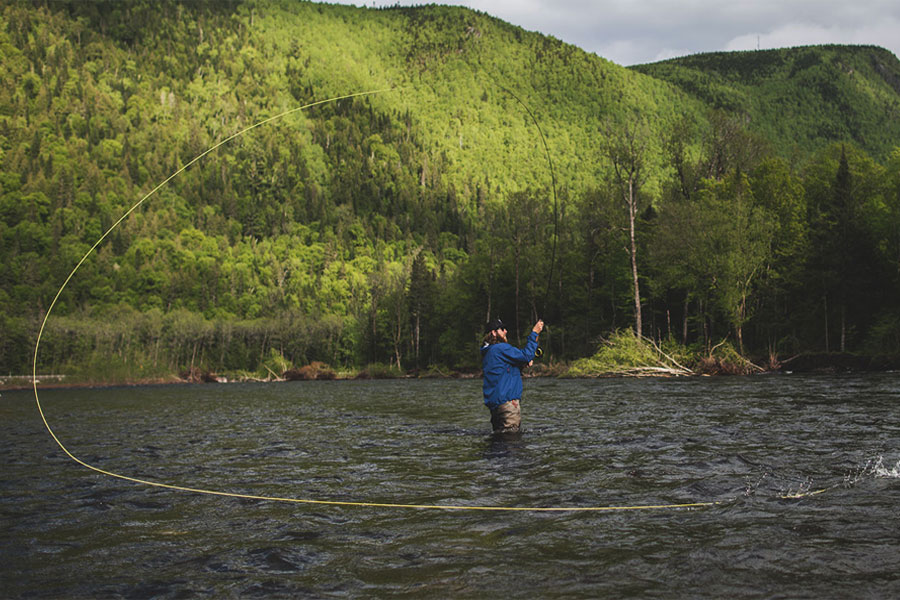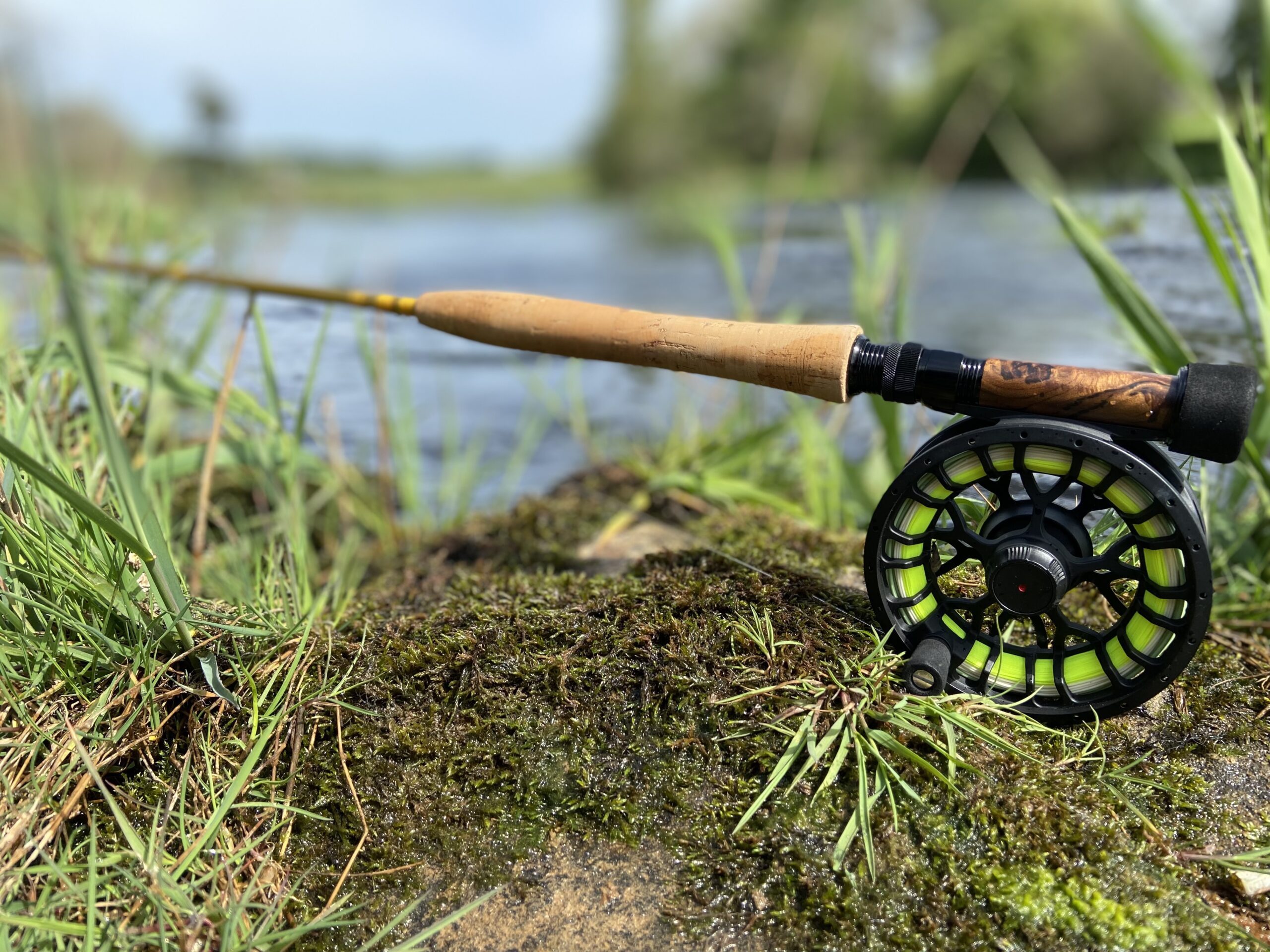Choosing the right fly fishing rod can get quite confusing, there seems to be so many variables to take into consideration. Like, what fly rod weight? What rod length? But don’t panic! In this article, we will give you a breakdown of everything fly rod related. So you have a much better understanding of fly rods and which applications they’re best suited to.
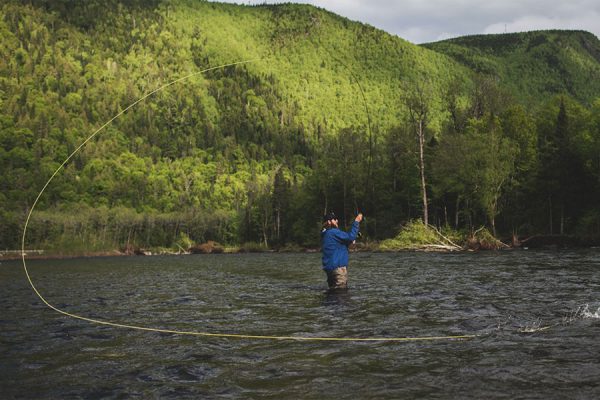
Fly Rod Action Guide
Rod action completely comes down to personal choice. However, as a good starting point, we have broken down the three main types of rod actions that are available and given you a brief understanding of their benefits.

Soft Action/Through Action
A soft action/through action is when the rod blank, bends through its entirety, from tip to butt. This action is usually associated with older/budget rods, however, in recent years there has been a demand for glass rods as they provide the perfect casting tool for short distance casting, protecting light breaking strain leaders and the ability to load/compress the rod easily during the cast. The slower casting stroke characteristics of these rods will help aid beginners as it allows them to perfect their timing better, but they don’t deliver the same sort of power that modern carbon rods with a middle to fast action offer, meaning casting distance will be limited.
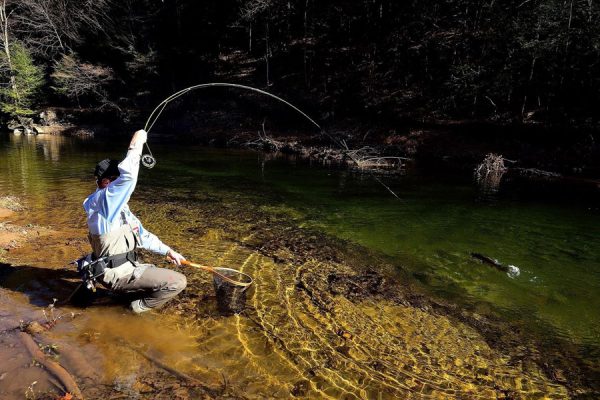
A Through Action Rod Bends Through It’s Entirety
Middle To Tip/Medium Fast Action
Probably the most commonly used fly rod action on the market today. This rod action will see the rod bend through the tip to the midsection of the rod. This is the best fly rod for beginners as they provide comfortable casting. The advantage of a medium fast action rod is that you can feel the rod load up the line on the back cast, this means you feel the weight of the line progressing through the back cast on the rod. This makes it easier to perfect your timing on the back cast, as the action can be forgiving if your cast timing is not spot on.
Tip Action/Fast Action
The benefit of fast action rods are their casting ability. They have more power than any of the other rod action type, which allows the user to cast further, they’re ideal for fishing in windy conditions and playing fish harder. It is the most unforgiving rod action available on the market and is not recommended to beginners. All the action of the rod is predominant in the top quarter section of the rod. Honing ones technique is required to really release the full potential of fast actioned rods.
What is the difference between fly rod weights?
So now you have a better understanding of what to look for in rod action, lets now dive into the world of rod line weights, this is where people become confused. We can assure you it’s a lot simpler than you think. All rods will stipulate their length and rod line casting weight on the rod blank itself. Fly lines are numbered by their line weight, for example: #6. The higher the number, the heavier the line, the heavier the line means the heavier the application and fish species they are designed to target. The fly weight also determines the line weight, if the fly is too heavy for the line weight then it will affect the presentation of the fly on the water, making it harder to control during the cast due to the line weight and fly weight not being perfectly balanced with each other.
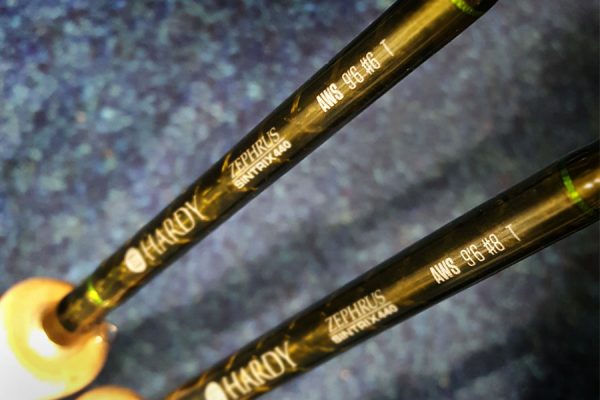
Line Weight And Rod Length Can Be Found On The Rods Blank
Let’s have a look:
Lines #0 – #3
Designed specifically for river anglers, these lines are of a specialist nature. They excel where a gentle or finesse presentation is required during good weather conditions. This weight of line is not recommended for beginners.
Lines #4 – #5
#4 is a pretty standard river fishing line, the #5 comes in a close second and is also ideal for dry fly tactics on smaller stillwaters or large rivers.
Lines #6– #8
These are the most commonly used line weights for stillwater trout fishing. Rods carrying these lines are generally aimed at the still water market in the UK and will cover most trout fishing applications.
Lines #9 – #11
Rods capable of throwing these weights of line are generally used for salmon, sea Trout, pike and saltwater applications.
- #9 – #10 – Pike
- #9 – #11 Double handed rods – Salmon and sea trout
- #9 – #11 Single handed rods – Saltwater ie. mackerel, pollock etc
- #10 – #11 are ideal for pike as it will deal with the large flies
Fly Rod Length
Rod length is another important factor to consider when choosing the right rod length. You need to consider the venues you will be fishing. Below we give you an overview of the various rod lengths available and what venues and species they will cover.

Choosing The Correct Rod Length For The Right Application Is Vital
Below 7’0″
Specialist river rods. Ideal for finesse tactics, using lighter lines and leaders to target small wild brown trout and grayling.
7’0″ – 8’6″
Also ideal for rivers or chalk streams and dry fly tactics.
9’0″ – 10’0″
These length of rods will suit most fishing situations, ideal for big still waters and big reservoirs to target trout. They’re a practical size to use from boat or bank. These length of rods provide better control and are ideal for beginners.
11’0″ – 12’0″
This length of rod is more commonly used on large lochs/loughs. Fishing traditional “loch style” this style is conventionally done from a boat. These rods are also a good length for targeting sea trout and salmon.
13’0″ – 15’0″
This length of rod is more of a specialist rod, and the majority of them will boast a double handle as they’re specifically designed to target salmon and sea trout. Double handled rods are designed for spey casting, which is the most commonly used casting technique for river salmon fishing. The length of a rod should be based on the size of the river, the average weight of fish you encounter and the weight of the line, which will be used.
Fly Rod Handles
Handle shapes vary as well and this will come down to personal preference and will be dictated by your casting grip. There are three main styles: full wells, half wells and cigar. The best way to determine what grip suits you is to test out various rods.

Most Fly Rods Come With Cork Handles
Handle Material
The majority of fly rod handles are made with cork, it feels comfortable in the hand even when your hands are wet. Cork is more sensitive in hand compared to some more modern rod handle materials like EVA foam. However, quality cork is becoming harder to obtain. EVA foam has several benefits over cork, EVA is a far more durable material, it’s easy to clean and wipe down and is lighter in the hand.
Double Handled
The majority of double handed rods are designed for salmon fishing, the need for the double handle is to help lift long lengths of line from flowing water on the river while spey casting. This helps control the line better and mend the line as it crosses the river. As stated earlier, most double handed rods come between 13″ – 15″ in length.
Rod Guides
Looking at a fly rod, you might notice that the guides are different from a conventional spinning rod. Let’s have a look at the various differences and the reasons behind the following guides used on fly rods.
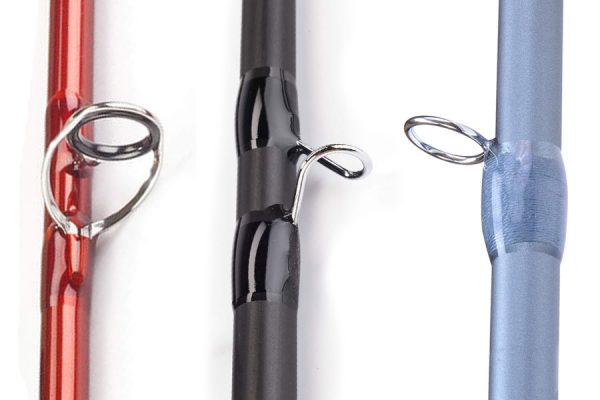
L to R: Stripper Guide, Snake Guide and Single Legged Guide
Stripper Guide
From the butt end of the fly rod, you will notice either one or two conventional looking guides – metal framed guides with ceramic inserts, these are known as stripper guides. These are the largest guides on any fly rod and are designed to be robust due to the high amount of wear they experience from the fly line itself.
Further up the rod, you will find two other kinds of guides: traditional “snake” guides which are very light in weight or more modern “single leg” guides which keep the wet line away from the rod blank more effectively while casting.
Snake Guides
These are the more traditional style of guide, they benefit from being lightweight and durable. Made up of stainless steel, the snake guide can produce a smoother cast due to its unique design. They also further reduce the friction of the wet fly line hitting the rod blank, which helps aid casting.
Single Leg Guides
The more modern guides, are made from a circular metal frame that houses a ceramic ring inside it – which reduces line friction on the cast. Single leg guides also have a smaller footprint on the rod blank, which makes the rod slightly lighter due to the amount of epoxy required for whipping on single leg guides. This in turn, can make a rod more comfortable to use and allows you to utilise the action of the rod blank more.
Summary
Hopefully, after reading through our article, you have a better understanding of the different components that are required to build a fly rod. If you require any more advice please don’t hesitate to contact us.

